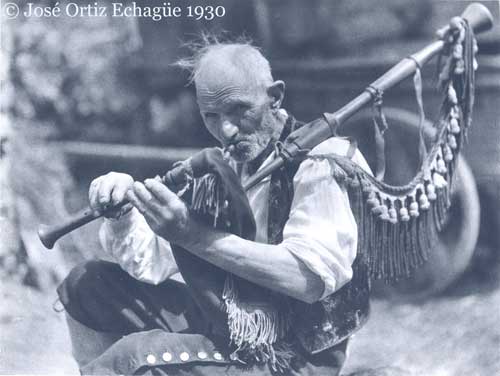Page 1 of 2
The photo of the bagpiper / La foto del gaiteru
Posted: Sat Dec 13, 2003 6:09 am
by Terechu
Art, I just realized that there’s a splendid old photo of a bagpiper (J.A. Menéndez Alvarez) in the
Pre-1940 Family Photo Album section. I don’t know whose it is, but there you can see a slightly different montera picona and a wonderful, worn-out Asturian bagpipe.
As to the picture “Nieto at the beach”, I bet the beach in question is Salinas, there are just 2 or 3 other beaches with dunes in Asturias, and they were wild beaches in those days, full of debris from the tides and nobody went there.
Another curiosity is the way the surname “Vuilla” is spelled here. There’s a hospital in Mieres called “Hospital Alvarez-Buylla” and I used to know someone who also spelled his surname “Buylla”.
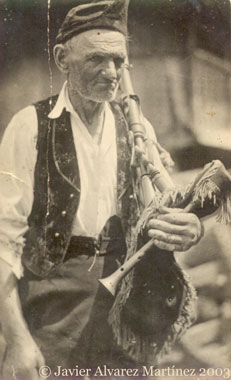
-------------------------------------------------------------------------
Art, acabo de darme cuenta que hay una espléndida foto antigua de una gaitero (J.A. Menéndez Alvarez) en
la sección Pre-1940 Family de “Photo Album”. No sé de quién será, pero ahí puedes ver una montera picona un poco distinta y una maravillosa y gastada gaita asturiana.
En cuanto a la foto “Nieto en la playa”, apuesto a que la playa es cuestión es Salinas, ya que sólo hay otras 2 o 3 playas con dunas en Asturias, y en aquellos días eran playas salvajes, llenas de basura que debajan las mareas y nadie iba allí. Otra cosa curiosa es la forma de escribir el apellido Vuilla. En Mieres hay un “Hospital Alvarez-Buylla” y yo conocía a una persona que también escribía su apellido “Buylla”.
Saludos
Terechu
Posted: Sun Dec 14, 2003 12:45 am
by Art
Hi, Terechu,
The man with the gaita is one of my great grandfathers, and a great-great grandfather of my Avilés cousin Javier Alvarez Martínez (who is also a member of the forum).
The first seven photos are related to my family. My grandparents are in the 3rd, 4th, and 5th photos.
I'll change the album to suggest that the beach in the 7th photo may be Salinas. That would make sense. Thanks for making a great deduction!
As for the montera picona José Antonio is wearing, it looks a little beat up, doesn't it? Or maybe it's one of the homemade monteras and they usually look bedraggled? Is he wearing it turned a bit so the side that sticks up is partly in front?
Is he wearing a traditional vest, too?
------------------
translated by Art & Reverso
Hola, Terechu,
El hombre con el gaita es uno de mis bisabuelos, y un tatarabuelo de mi primo de Avilés, Javier Alvarez Martínez (quien es también un miembro del foro).
Las siete primeras fotos son relacionadas con mi familia. Mis abuelos están en las fotos en los tercero, cuarto, y quinto lugares.
Cambiaré el álbum para sugerir que la playa en la 7a foto pueda ser Salinas. Tendría sentido. ¡Gracias por hacer una gran deducción!
Sobre la montera picona José Antonio se lleva, ¿parece un poco dado una paliza la montera, verdad? ¿O tal vez esto sea uno de las caseras y por lo general parecen desordenadas?. ¿La lleva girado un poco y el lado que sube al pico es más al frente que normal?
¿Lleva él una chaleco tradicional, también?
Piper and montera
Posted: Sun Dec 14, 2003 9:52 am
by Carlos
Hi all.
Art and Terechu, this is a beautiful example of montera. THIS is a normal traditional montera. The Art relative wear it right, with the wing parallel to the left cheek, as me when I wear my asturian custom. It's only a kind of optical illusion which we could think the montera is turned. Really, the low ends of the wing, the forward and the back ones, on the forehead and on the nape, do not finish in straight angle (90 º) with the low edge of the cap. I will try to do a few drawings in order that there am understood better how it's the original form. The low end of the wing, in the part where it joins with the edge of the cap, actually continues towards the right without interruption, up to wing turning into other one smaller of the right side of his face. This wing, if it was bigger, could be seen clearly as a wing, and if it was smaller one saw only as a double curbing up. This one is exactly the case with the montera cap of your ancestor, Art, and that one curbing is what is in touch with his right ear. It isn't a question that the montera is spongy, only it is a question of the consistency of the fabric or of the fact that is very worn.
Precisely for this motive, when a "montera picona" cap wanted to be obtained, with the wing well stiff, it was appealed to arming her within with an interlining to make her more rigid, as I explained in another message.
With regard to the bagpipe, undoubtedly it's a question of an Asturian bagpipe, without the minor confusion. From the details of the profile of the turned pieces, almost I'm completely sure that it's a question of a bagpipe of Cogollu, the most famous craftsman of Asturias, in which bagpipes inspire all the modern makers.
Regards.

Posted: Sun Dec 14, 2003 3:08 pm
by Terechu
Art, Carlos and the rest of you,
I absolutely LOVE that photo! I have seen many old men like him in my childhood, wiry men with huge hands and broad foreheads (and big ears

). You still can see some out in the country. He doesn't look bedraggled to me, he's wearing a perfectly clean white shirt and the dusty aspect could be the picture quality itself. The montera does look a little beat up, but then again, if he only wore it when he performed, it most likely lasted him a lifetime. You can't wash a felt cap without shrinking it and you know that back then any type of cloth was very expensive and nobody threw away a cap because it was old or dirty. You wore it until it had holes in it. The same goes for the bagpipes, of course.
-------------------------------------
Art, Carlos y todos los demás,
Me chifla esa foto! Cuando era pequeña se veían muchos hombres como él, hombres correosos con manos enormes y frentes anchas (y orejas grandes

). Todavía se les puede ver en las zonas rurales. A mí no me parece que esté desaliñado, lleva una camisa blanca perfectamente limpia y el aspecto polvoriento podría ser por la calidad de la foto misma. La montera si parece que llevó una paliza, pero por otra parte, si sólo la ponía para tocar, lo más probable es que le durara toda la vida. No se pueden lavar gorras de fieltro sin que mengüen y en aquella época el paño de cualquier tipo era muy caro y nadie tiraba una montera porque fuese vieja o estuviese sucia. Se llevaba hasta que tuviera agujeros. Lo mismo pasaba con las gaitas, claro.
Saludos
Terechu
Is he the same piper?
Posted: Sun Dec 14, 2003 4:58 pm
by Carlos
Posted: Sun Dec 14, 2003 6:56 pm
by Art
Wow, that could be my great grandfather. I've asked the family to take a look, too.
Does it look like the same gaita? At first glance, the drone's first section seems much thinner in Carlos' image, but now I see that it's the stock (which is much thicker) I'm seeing in the first photo. The first section really is thin! Yes, I think this could be the same gaita.
The chaleco looks similar, don't you think?
What do you know about the second photo, Carlos?
----------
Vaya, podría ser mi bisabuelo. He pedido a la familia, también.
¿Parece la misma gaita? A primera vista, la prima de la roncón parece mucho más estrecha en la imagen de Carlos, pero ahora yo veo que es el asiento (cual es más gordo) que veo en la primera foto. ¡La prima realmente es delgada! Sí, pienso que podría ser la misma gaita.
El chaleco parece similar, ¿no?
¿Qué sabes de la segunda foto, Carlos?
Posted: Sun Dec 14, 2003 11:36 pm
by Bob
The resemblance between the gaiteros in the two photos is amazing. I find it difficult to imagine that they are not two images of the exact same person, taken within a year or two of each other, perhaps even on the same day.
In addition to the facial features themselves, the hands are relatively large, with long and thick fingers, in both photos. The gaitas appear somewhat different, however.
Bob
Posted: Mon Dec 15, 2003 12:47 am
by Art
Carlos, would it be possible for me to get a larger scan of this photo?
----------
¿Carlos, sería posible para mi obtener un escan con más datos de esta foto?
Posted: Mon Dec 15, 2003 5:20 am
by Terechu
Alright, here's the party pooper! I hate to say this and disappoint you, but I don't see any similarity in their faces. Art's great-grandpa has a very broad forehead (and do I know about broad foreheads!

) and different shaped ears. Also his face is more triangular, his chin is more pointed. The huge hands are typical of those days, when boys had to start working after the 4 years of mandatory schooling (at age 10 or 11) and their hands got strong from lifting and carrying loads. The jobs available to them were either in the coal mines, the farms or the fishing boats, and they all involved heavy physical work.
Besides, the bagpipe is different, and bagpipe then lasted them to their dying day.
Sorry guys!

-----------------------------------------------------
Vale, aqui llega la "aguafiestas"! Me fastidia decir esto y decepcionaros, pero no veo ninguna similitud en sus caras. El bisabuelo de Art tiene una frente muy ancha (y de frentes anchas sé un rato

) y las orejas de otra forma. Además su cara es más triangular, la barbilla más afilada. Las manos enormes eran típicas de aquellos días, cuando los niños tenían que empezar a trabajar después de los 4 años de escuela obligatorios (a los 10 u 11 años) y sus manos se fortalecían de levantar y portar pesos. Los trabajos que había para ellos eran en las minas, la agricultura o la pesca, y todos ellos suponían trabajo físico duro.
Además, la gaita no es la misma, y las gaitas duraban tanto como el paisano.
Lo siento chicos

Terechu
Los buylla y builla
Posted: Mon Dec 15, 2003 4:38 pm
by Xosenrique
hola a todos/as:
Aunque no es el tema a debate, me gustaría contaros la leyenda de los Buylla.
Su casa solariega dicen los expertos e genealogía que procede de Arances (Castrillon) desde donde se extendio por toda asturias. Sin embargo la gran mayoría de los Buyllas actuales proceden de la rama del concejo de Gozón.
Entre los Buylla y Builla corre la leyenda de que este apellido llegó a Gozón a través de un pirata que tuvo un montón de encuentros amorosos en la zona. Para reconocer a sus hijos primogénitos de los bastardos a estos últimos les ponía el apellido Builla. Así los Buylla eran los reconocidos y los Builla los bastardos.
Es sólo una leyenda sin fundamente, pero muy curiosa.
Enrique
More details on the second piper
Posted: Mon Dec 15, 2003 6:42 pm
by Carlos
This evening I spoke with the person who provided to me the image of the piper, Gausón Fernande, member of the Ethnographic Group Belenos, who edits the magazine "Asturies". The person in the photo apparently appears as "Toño, from Raíces (Castrillón)", and the image was published about the years 29-30 of the XXth century, in a book titled "People and Suits" (Tipos y trajes), being the author of this one and other photos the photographer Ortiz Echagüe. Castrillón is situated in the same geographical region that Avilés, very nearby, and besides the personage, apart from the physical similarity, is called himself Toño, diminutive of Antonio, whereas the great-grandfather of Art was called José Antonio. It's perfectly possible that there am called a Jose Antonio Toño ado. Certainly the jacket seems to be the same, and it's not dirty, but the fabric has any kind of print in the shape of flowers or anything similar.
I don't believe that it could discard yet the fact that he's the same person. It's necessary to bear in mind that between the photo of Art (1910) and mine (1930) they have passed 20 years, unless Art knows with certainty that for this date his great-grandfather already was not alive, and it isn't also completely definitive, because the photo of the book could be taken before the publication of the book.
About the bagpipe that appears in both photos, neither it's determinant. The bagpipes in that epoch were made mainly of buxu (Buxus Sempervirens, Boxwood), because the tropical wood was very rare and besides very expensive. This is a matter that I know well, and in the space of 20 years the Boxwood can get dark considerably: newly turned, the wood is of a color between yellow and sand, but after the years the tone becames hazelnut and even brown, by photo-oxidation. On the other hand, the first photo is taken outdoors, while the second one is an interior closed place, and with not too many lighting, which also helps to make appear the wood as darker.
The bag garment of the bagpipe and the bangs also seem to be equal in both photos. For the rest, I'm sorry to contradict Terechu, but not only the pipers were in the habit of changing instrument, but even free pieces, until they were finding what more they liked. For this reason, also it can be a question of the same person with two different bagpipes, though I might affirm neither a thing nor other one.
I believe that the determinant thing is to establish clearly if the physical similarity is sufficient to say if it's a question of the same person or not. The feature that seems to me to be more discordant is the form of the left ear of my photo, which seems to be more separated from the head. But here also it's necessary to bear in mind that they are the opposite ears those that can be seen in both photos, and there are people who has an ear more separated that other one, besides which the cartilage of the ears and of the nose continues growing during the whole life, and 20 years are a lot of time, if that it's the difference of dates between both photos.
On the other hand, Art, my friend Gausón does not have any disadvantage in which you scan, extend or print the photo. The Group Belenos used her some years ago as part of a poster-calendar. And not only it, he asks me to see the photo of your great-grandfather, and besides he would be very interested in that you and other members of this community write some articles telling familiar histories as those who appear in these pages, with a view to her publication in the magazine "Asturies", which has a magnificent presentation in full color. These articles would be signed by his Asturian-Americans authors, and might be written in English, though finally they would published in Asturian language.
So I wait for your answer.
Regards.

Posted: Tue Dec 16, 2003 3:53 am
by Art
Ah, this is very good!
Given the way my family remembers him, José Antonio Menéndez Alvarez apparently went by "Antonio" more than "José". That fits with "Toño."
Plus, he was born in 1848 and died in 1935, so the years fit, too.
Castrillón is also a fair match. He was the son of José Menéndez and Manuela Alvarez, both of Illas (somewhere near the Castrillón and Avilés border, I assume). He married Maria Conde Alonzo, whose parents were Juan Conde of San Cristóbal (Avilés) and Maria Alonzo of Pillarno (Castrillón). So the family has roots in Castrillón.
Does anyone know where Raices is located in Castrillón? I don't see any villages with that name in Asturias in my atlas, but there is a river flowing past Pillarno and ending up in the Ria de Avilés, so maybe it's somewhere near Pillarno?
As to the appearance of the two men, they look very similar to me. Lighting conditions can make a huge difference the way 3-D shapes look in photos. I agree the ears are different, but they are, in fact, not the same ear (being right and left), so there could have been a difference in his ears, or it could be partly a difference of lighting.
The thing that I find most convincing is that the chaleco looks the same in both of the photos. Does anyone know if this would have been a common pattern for the cloth used in chalecos?
Carlos, I'd be very interested in writing something up for Asturies. It might take a little more research.... Ah, another trip to Asturias!
By the way, I was charmed that your friend, Gausón Fernande, is a member of Belenos. I was listening to them before reading your message tonight!
[Correction: Oops. Fundación Belenos is a group of intellectuals interested in Asturian culture and language. Beleño is a very good Asturian band, i.e. "musicians".]
---------
translated by Art & Reverso
¡Ah, esto está excelente!
Considerando como mi familia recuerda a él, José Antonio Menéndez Alvarez se llamó "Antonio" más que "José". Esto corresponde bien con "Toño".
Más, nació en 1848 y murió en 1935, entonces los años corresponden, también.
Castrillón es también un posibilidad. José Antonio fue hijo de José Menéndez y Manuela Alvarez, ambos de Illas (en algún sitio cerca del Castrillón y la frontera de Avilés, asumo). Él se casó con María Conde Alonzo, cuyos padres fueran Juan Conde de Cristóbal San (Avilés) y María Alonzo de Pillarno (Castrillón). Entonces la familia tiene raíces en Castrillón.
¿Sabe alguien dónde Raices esta en Castrillón? ¿Yo no veo ningún pueblo con aquel nombre en Asturias en mi atlas, pero allí fluye un río por delante Pillarno y termina en el Ria de Avilés. Tal vez esté en algún sitio cerca de Pillarno?
En cuanto al aspecto de los dos hombres, ellos me parecen muy similares. Las condiciones de iluminación pueden hacer una enorme diferencia de la manera de la mirada de formas 3-D en fotos. Estoy de acuerdo que los orejas son diferentes, pero ellos no son, de hecho, el mismo oreja (son derecho e izquierdo), así podría haber sido una diferencia en sus orejas, o esto podría ser en parte una diferencia de iluminación.
La cosa que encuentro el más convincente consiste en que el chaleco mira el mismo en ambos de las fotos. ¿Sabe alguien si hubiera sido un diseño común para el paño usado en chalecos?
Carlos, estaría muy interesado escribir algo para la revista Asturies. Esto podría precisar un poco más investigación.... ¡Ah, otro viaje a Asturias!
A propósito, me encanta que tu amigo, Gausón Fernande, es miembro de Belenos. ¡Yo les escuchaba esta noche antes de leer tu mensaje!
[Corrección: Opa. Fundación Belenos es un grupo de intellectuales interesados en la lengua y cultura asturiana. Beleño es una banda muy buena, esto es "músicos".]
raices
Posted: Tue Dec 16, 2003 1:02 pm
by jomaguca
Art,despues de pasar Piedras Blancas por la carretera que va hacia Aviles esta el Campon que tambien es un grupo de casas, esta al lado de Salinas ,sigues la carretera hacia Aviles y mano izquierda veras el centro de salud de Raices, ese edificio fueron las antiguas escuelas de Raices ,pues detras del centro de salud es el pueblo de Raices que llega casi hasta la playa de Salinas, el raices de aquellos tiempos hoy se conoce por Raices Viejo y precisamente por ahi pasa un rio que se llama el rio raices, sigues hacia Aviles y veras un puente que por encima pasa el ferrocarril de la linea GIJON-FERROL, pues esa poblacion se llama Raices Nuevo y esta dividida por la carretera general, Raices Nuevo en los tiempos de tus abuelos no existia ,sigues mas adelante y esta Cristaleria Española aqui empieza el municipio de Castrillon ,y asi unos barrios hasta llegar a Aviles.

Espero que me hallas entendido.

Posted: Tue Dec 16, 2003 3:31 pm
by Art
Sí, lo explicas bien, Jomaguca. Gracias. Tu conocimiento del área te hace un tesoro asturiano!
¿Raices Viejo es pequeño? No esta entre los "nucleos habitados" en el plano que tengo. Debe ser que hay muchos nucleos no recordadas (en este atlas--or tal vez en ninguna mapa!).
Este detalle no concorda bien con mi bisabuelo, aunque es sólo una distancia corta de Raices Viejo a donde él vivió la mayor parte de su vida adulta. Hoy la familia piense de Salinas como la parte de su zona (lugares que conocen bien). No sé si era verdad para la familia en los años 1920.
----------------
Yes, you explain it well, Jomaguca. Thanks. Your knowledge of the area makes you an Asturian treasure!
Is Old Raices small? It's not among the inhabited settlements in the map I have. It must be taht there are many settlements not remembered/recorded (in this atlas or maybe on any maps!).
This detail doesn't fit my great grandfather very well, although it would only be a short distance from Raices Viejo to where he lived most of his adult life. Today the family views Salinas as part of their stomping ground. I don't know whether that was true of the family in the 1920s.
Posted: Tue Dec 16, 2003 9:10 pm
by Art
Art - 10/22/04:
I've changed my mind. I no longer believe what I wrote in this message. I'll post corrections here:
http://www.asturianus.org/forum/viewtop ... =3298#3298
-----
He cambiado de opinión. Ya no creo en lo que escribí en este mensaje. Voy a poner mis correciónes aquí:
http://www.asturianus.org/forum/viewtop ... =3298#3298
Carlos has made a very good suggestion: compare the heads side by side. Well, I've blown them up, so they can't sit side by side when they're this large. First is José Antonion Menéndez Alvarez. Second is Toño of Raices.
---------
Carlos ha hecho una sugerencia muy buena: compare las cabezas espalda con espalda. Pues, los he ampliado, entonces ellos no pueden sentarse espalda con espalda como son tan grandes. Primero es José Antonion Menéndez Alvarez. El segundo es Toño de Raices.
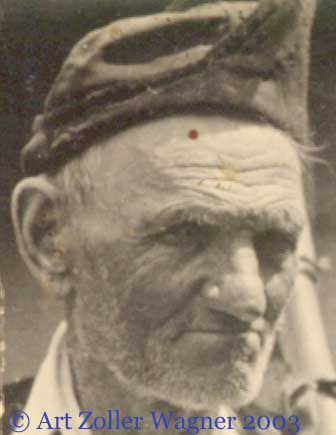
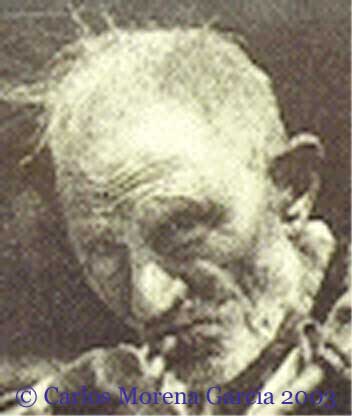
I'm no longer certain that this is the same person. Maybe Terechu is right, that these men, through their common experiences, have aged in similar ways, but they are different men.
The features I see being most different, now that they are enlarged, are the creases under the eyes and the creases in the cheeks. There is also a qualitative difference in the appearances, but it's hard to put a finger on it.
Now, take a look at their chalecos. Again, first I show José Antonio Menéndez Alvarez, then Toño of Raices.
------------
Ahora no estoy seguro que estos son la misma persona. Tal vez Terechu tenga razón, que estos hombres, por sus experiencias comunes, han envejecido de modos similares, pero son diferentes hombres.
Los rasgos veo ser los más diferentes, ahora que ellos son ampliados, son los pliegues bajo los ojos y los pliegues en las mejillas. Hay también una diferencia cualitativa en las apariciones, pero es difícil de poner un dedo sobre ello (es difícil dar lo un nombre).
Ahora, mire a su chalecos. Otra vez, primero muestro a José Antonio Menéndez Alvarez, entonces a Toño de Raices.
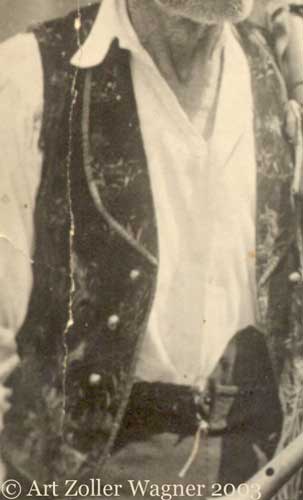
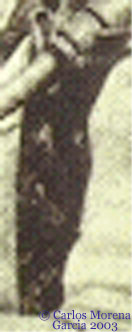
I was surprised to see that when enlarged, the pattern is probably not in the cloth (like an intentional floral pattern) but due to wear, at least in the vest that José Antonio Menéndez Alvarez is wearing. It's hard to tell in the image of Toño's vest what is going on.
What do you all think?
What kind of material did they used to use to make these old chalecos?
----------------
Estuve sorprendido de ver que cuando ampliado, el diseñoo probablemente no es en el paño (como un diseño intencional floral) pero debido a degaste (o uso), al menos en el chaleco que se lleva José Antonio Menéndez Alvarez. Es difícil ver en la imagen del chaleco de Toño exactamente que pasa.
¿Qué pensáis, mis amigos?
¿Qué tipo de tela se usaban para hacer estos chalecos viejos?
Art 10/22/04:
Por favor, vea los cambios aquí:
http://www.asturianus.org/forum/viewtop ... =3298#3298
---
Please see the changes here:
http://www.asturianus.org/forum/viewtop ... =3298#3298


